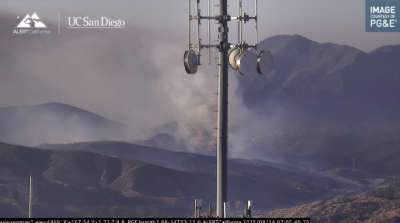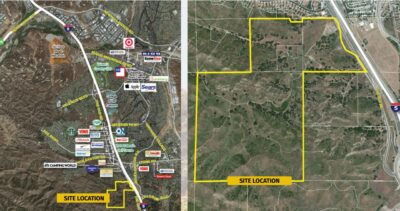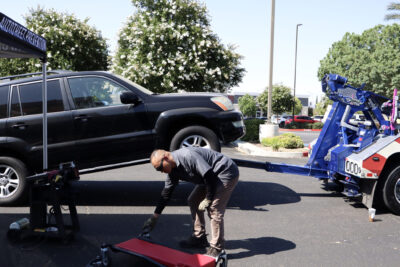Less than three months after the Chiquita Canyon Landfill’s relief assistance program was ended, the L.A. County Department of Public Health on Tuesday sent a letter to the landfill’s operators directing that the program be reinstated.
In the letter addressed to John Perkey, Waste Connections vice president and legal counsel, and Steve Cassulo, general manager of the Chiquita landfill, Public Health Director Barbara Ferrer wrote that the landfill has “failed to offer any support to affected residents” after terminating the relief program, and conditions at the landfill have only worsened since then.
Waste Connections is the parent company of Chiquita, which officially closed at the start of the year, stating in a letter on New Year’s Eve that operations were “no longer economically viable.” Noxious odors have been emanating from the landfill for more than two years — stemming from a subsurface reaction for which a joint task force of state, county and federal officials have yet to identify a root cause — and have caused “recurring health symptoms and a significantly diminished quality of life” for residents of Castaic, Val Verde and others near the landfill, the letter states.
Cassulo stated at a community meeting in March that approximately $25 million was given out over 12 months of the relief program, with the final payments sent out in March.
John Musella, spokesman for the landfill, sent the following statement on Thursday via email:
“While Chiquita is still evaluating the contents of the letter from Dr. Ferrer,” Musella wrote, “we note that the letter itself does not provide or cite any objective data in support of its directives, appears to ignore the conclusions from health evaluations conducted by both county and Chiquita-retained toxicologists, and gives no recognition to the fact that Chiquita has already paid $25 million into the community for similar efforts. We look forward to a dialogue with the Department of Public Health on these issues.”
The coverage area of the reaction at the landfill has “potentially tripled in size” since the relief program ended, Ferrer wrote, referencing recent analysis from CalRecycle, the state agency in charge of trash management.
Ferrer also referenced multiple letters that L.A. County 5th District Supervisor Kathryn Barger, who represents the Santa Clarita Valley, has sent to the operators of the landfill since last year. In a news release issued by Barger’s office on Tuesday, she voiced her support for the directive, stating that it “reinforces the county’s position by formally documenting the urgent need for relief and mitigation, including temporary relocation and home hardening for residents near the landfill.”
“I fully support the Department of Public Health’s decision to issue this directive. It underscores the health impacts we’ve long identified and serves as a strong complement to the county’s lawsuit against the landfill,” Barger stated in the release. “This action reaffirms why legal intervention was necessary and reflects the county’s coordinated commitment to protecting the well-being of impacted residents.”
The county filed a lawsuit against the landfill and Waste Connections in December to address “ongoing environmental and public health hazards caused by the landfill’s operations,” as well as to seek relief for “impacted communities under siege,” according to a release from Barger’s office in December announcing the lawsuit.
A query sent via email to the Department of Public Health’s media relations division regarding the next steps if the landfill declines to reinstate the program elicited the following response: “The county has filed a lawsuit for community mitigation and will continue to pursue all available legal remedies to ensure residents receive necessary support.”
Ferrer’s letter on Tuesday states that conditions at the landfill have worsened since the relief program ended, referencing 550 air quality complaints that were lodged by members of the public in April to the South Coast Air Quality Management District, which oversees air quality regulations across much of Southern California.
Orders from the California Environmental Protection Agency’s Department of Toxic Substances Control and the Solid Waste Management Program of Public Health were also referenced by Ferrer. The latter agency directed the landfill to “control the expansion of the (subsurface elevated temperature) event and to install a thick geomembrane cover over all areas of the landfill that are not currently covered and to which the reaction area has expanded or has the potential to expand.”
“This added measure is needed to control the gas emissions and odors from reaching the ambient air in the communities near the landfill,” Ferrer wrote. “The installation of the required cover will likely take months, and in the meantime, the noxious odors will persist. Impacted residents need immediate relief.”
Oshea Orchid, a Val Verde resident and attorney representing residents near the landfill in a lawsuit against it, said in a statement sent via text on Wednesday that she is “pleased to see that Public Health is finally stepping up to hold the landfill operators responsible for the public health crisis that they have created.” She added, though, that the relief program, if reinstated, needs further government oversight.
“The relief program being voluntary and without government oversight was always problematic,” Orchid wrote. “The landfill’s sudden termination of its relief program left residents without the ability to relocate or continue necessary home-hardening efforts. The landfill has also refused to provide rationale for how the relief program was implemented and what amount of relief was available to residents. While the landfill should be held responsible for funding relief to residents, Public Health ultimately has a duty to ensure relief is available to residents to protect public health during this serious environmental crisis.”








